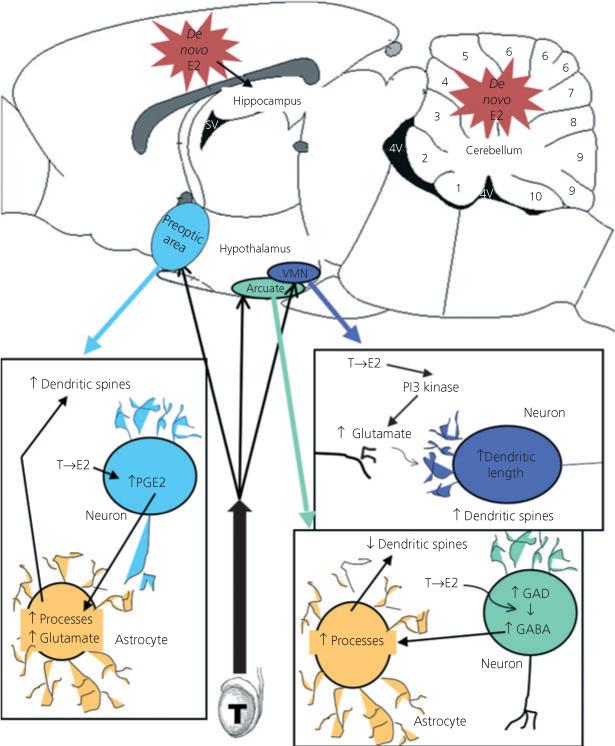Fig. 1.

Mechanisms of oestradiol-mediated organisation of sexually dimorphic synaptic patterning. Three distinct hypothalamic nuclei show profound sex differences in the number and/or density of dendritic spines and attendant excitatory synapses. In each of these regions, oestradiol (E2) is locally aromatised from testicularly derived testosterone (T). The preoptic area is a critical brain region for control of male sexual behaviour. Early in life, males have two- to threefold more dendritic spines along a given length of dendrite than females. Oestradiol increases the synthesis of prostaglandin E2 (PGE2) by up-regulating the rate-limiting cyclooxygenase 2 (COX-2) enzyme (13). PGE2 is then believed to act on neighbouring astrocytes, increasing the stellate morphology of this cell type and inducing the release of glutamate, which in turn promotes the formation of dendritic spines on the originating or neighbouring neurones. In the ventromedial nucleus (VMN), a critical brain region controlling female sexual behaviour, oestradiol directly promotes the release of glutamate from neurones via a non-genomic activation of PI3 kinase. This presynaptic glutamate then promotes dendritic growth and formation of dendritic spines on the postsynaptic neurone (31). The arcuate nucleus contributes to control of the anterior pituitary and to female reproductive behaviour. In this nucleus oestradiol acts in neurones to increase GABA synthesis by up-regulating the rate-limiting enzyme glutamic acid decarboxylase (GAD). GABA then acts on neighbouring astrocytes, increasing process growth and branching (19). The end result is a decrease in the density of dendritic spine synapses, the opposite of the pattern achieved in the other two brain regions. There is also emerging evidence for de novo, from cholesterol, synthesis of oestradiol in the developing hippocampus, cortex and cerebellum, although the mechanisms by which oestradiol might be acting in these brain regions are as yet unknown.
